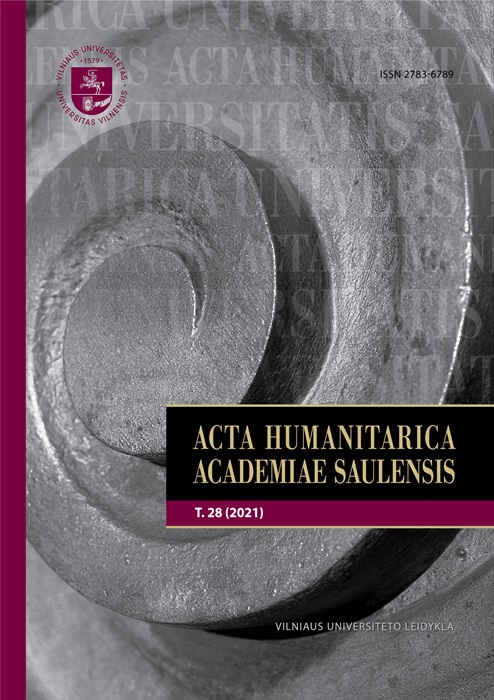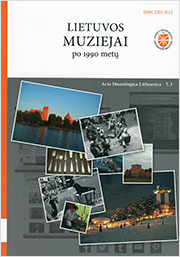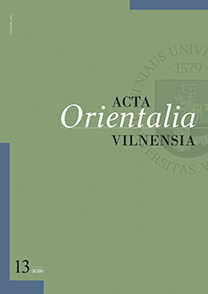
Įkurtas 2006 m. Žurnalas leidžia kalbotyros, literatūrologijos, istorijos, filosofijos, etnologijos ir kitų humanitarinių mokslų krypčių straipsnius. Tyrimuose plėtojamas įvairialypis regionalistikos diskursas.

Įkurtas 1994 m. Periodinį mokslo žurnalą Acta medica Lituanica leidžia Lietuvos mokslų akademija, bendradarbiaudama su Vilniaus universiteto Medicinos fakultetu ir Nacionaliniu vėžio institutu. Jame spausdinami straipsniai apie aukšto lygio mokslinius tyrimus, atliekamus daugiausia Lietuvoje, Baltijos šalyse ir Rytų Europoje. Registruotas Scopus nuo 2021 m.

Įkurtas 2013 m. Nagrinėja muziejų istorijos, rinkinių valdymo, metamuzeologijos, ekspozicijų ir parodų rengimo, paveldo komunikacijos, skaitmeninių technologijų taikymo, edukacijos, vadybos ir politikos klausimus.

Įkurtas 1999 m. Nagrinėja archeologijos istorijos ir metodologijos klausimus, Baltijos regionui reikšmingus archeologinių tyrimų duomenis. Registruotas Scopus nuo 2021 m.

Įkurtas 1991 m. Nagrinėja teorinius ir metodologinius švietimo ir ugdymo bei švietimo politikos ir kultūros analizės klausimus. Registruotas Scopus (Q4) nuo 2019 m.

Įkurtas 2007 m. Nagrinėja buhalterinės apskaitos, audito ir analizės klausimus.

Įkurtas 1960 m. Nagrinėja šiuolaikinės ekonomikos, sektorinės situacijos ir verslo plėtros strategijos vietos ir užsienio rinkose klausimus centrinės ir rytų Europos šalių ekonominio vystymosi kontekste. Registruotas Scopus (Q4) nuo 2020 m.

„Colloquia“ – du kartus per metus leidžiamas recenzuojamas Lietuvių literatūros ir tautosakos instituto mokslo žurnalas. Žurnalo misija – skleisti XX–XXI a. Lietuvos bei Rytų ir Vidurio Europos regiono literatūros tyrimų, teorijos darbų, tarpdalykinių literatūros studijų medžiagą ir skatinti mokslinių idėjų apykaitą.

Įkurtas 1997 m. Žurnalas publikuoja mokslinius tyrimus apie sovietų ir nacių totalitarinių režimų nusikaltimus Lietuvoje 1939–1991 m., ginkluotos bei neginkluotos rezistencijos momentus, totalitarinių režimų poveikį visuomenei.

Įkurtas 1994 m. Nagrinėja informacijos ir žinių visuomenės, žinių vadybos, organizacijos komunikacijos vadybos, kultūros tyrimų, žiniasklaidos ir naujųjų medijų, globalios ir tarpkultūrinės komunikacijos, mokslotyros klausimus. Registruotas Scopus (Q3) nuo 2018 m.

Įkurtas 2002. Publikuojami originalūs jaunųjų mokslininkų parengti moksliniai straipsniai, kuriuose skelbiami autorių biomedicinos, fizinių, humanitarinių, socialinių, technologijos mokslų srityse atliktų tyrimų rezultatai.

Įkurtas 1958 m. Publikuoja įvairių kalbų sinchroninius ir diachroninius, taip pat ir tarpkalbinių aspektų, tyrimus. Registruotas Scopus nuo 2021 m.

Įkurtas 1961 m. Skirtas tarpdisciplininiams spausdintinių ir skaitmeninių leidinių tyrimams, apimantiems knygos ir periodikos istoriją, istoriografiją ir kultūrą, tradicinę ir skaitmeninę leidybą, skaitymo, rašytinių medijų komunikacijos, spausdintinio ir rankraštinio paveldo problemas. Registruotas Scopus (Q1) nuo 2018 m.

Įkurtas 2014 m. Publikuoja kriminologijos tematikos straipsnius.

Įkurtas 1992 m. Publikuoja straipsnius apie Lietuvos praeitį, jos istorinę raidą, lietuvių tautos valstybingumą, materialinės ir dvasinės kultūros raidą, jos sąveiką su kitomis tautomis, vietą pasaulio civilizacijoje.

Įkurtas 1993 m. Publikuoja chirurgijos srities straipsnius.

Įkurtas 1990 m. Publikuoja statistikos teorijos ir metodologijos, statistikos taikymo ekonomikoje, fizikoje, technologijose, biomedicinoje ir socialiniuose moksluose tyrimus, analizuoja statistikos metodus oficialioje statistikoje, nagrinėja statistikos istoriją.

Įkurtas 2007 m. Publikuoja įvairių kalbos lygmenų – fonetikos ir fonologijos, morfologijos ir sintaksės, leksikos ir diskurso, semantikos ir pragmatikos – tyrimus.

Įkurtas 1961 m. Publikuoja straipsnius, pristatančius naujus ir svarbius įvykius visose matematikos srityse.

Įkurtas 1958 m. Publikuoja straipsnius apie Lietuvos ir užsienio literatūrų ir kultūrų tyrimus. Registruotas Scopus (Q4) nuo 2020.

Įkurtas 2010 m. Publikuoja straipsnius apie naujus organizacinių ir rinkos tyrimų aspektus besiformuojančios ekonomikos šalyse. Registruotas Scopus (Q3) nuo 2016 ir Web of Science nuo 2021.

Įkurtas 1997. Publikuojami neurologinių, neurochirurginių bei gretimų ligų etiopatogenezės, klinikos, diagnostikos, gydymo bei profilaktikos laimėjimų straipsniai.

Įkurtas 1997 m. Publikuoja tarpdisciplininius netiesinių procesų ir reiškinių mokslo darbus, įskaitant netiesinį sistemų ir gamtos reiškinių modeliavimą. Registruotas Scopus (Q2) nuo 2009, Web of Science (Q1) nuo 2010.

Įkurtas 1989 m. Publikuoja straipsnius politikos mokslų, tarptautinių santykių ir tarpdisciplinėms temomis. Registruotas Scopus (Q4) nuo 2012.

Įkurtas 1968 m. Filosofijos žurnalas, skelbiantis akademinius straipsnius, knygų recenzijas ir akademinio gyvenimo kroniką. Registruotas Scopus (Q2) nuo 2002, Web of Science nuo 2005.

Įkurtas 1962 m. („Psichologija“ – nuo 1980 m.). Publikuoja straipsnius visų psichologijos mokslo krypčių ir tarpdisciplinėmis temomis.

Įkurtas 2004 m. Publikuoja religijos fenomeno bei religijos ir kultūros santykio tyrimų, integruotai apimančių religijotyrines, religijos filosofijos ir etc. disciplinas, tematikos straipsnius.

Įkurtas 1999 m. Skirtas lingvistiniams tyrimams, literatūros naratyvų ir kontekstų problematikai, reklamos diskurso paveikumo klausimams, vertimo teorijai ir praktikai, audiovizualiniams tyrimams. Registruotas Scopus (Q1) nuo 2019.

Senoji Lietuvos literatūra – recenzuojamas Lietuvių literatūros ir tautosakos instituto mokslo žurnalas, išleidžiamas 2 kartus per metus. Periodinis leidinys eina nuo 1992 m. Žurnalą kuruoja instituto Senosios literatūros skyrius. Žurnalas skirtas senosios (XIV–XIX a.) Lietuvos ir Prūsijos daugiakalbės literatūros bei raštijos tyrimams.

Įkurtas 2009 m. Vilniaus universiteto Skandinavistikos centro. Publikuoja akademinių straipsnių rinkinius, akademines knygas ir skandinavų literatūros vertimus.

Įkurtas 1997. Skirtas slaugos, akušerinės priežiūros, burnos priežiūros, reabilitacijos ir visuomenės sveikatos priežiūros specialistams.

Įkurtas 1994. Skirtas įvairių semiotikos problemų gvildenimui ir semiotinių prieigų taikymui kultūros diskursų analizėje.

Įkurtas 1998 m. Yra tarptautinis leidinys, siekiantis papildyti mokslinius bei praktinius neįgaliųjų ugdymo bei socialinio dalyvavimo resursus. Čia kuriamas mokslininkų ir praktikų, dirbančių su negalę turinčiais žmonėmis įvairiausiose srityse ir aplinkose, forumas.

Įkurtas 1997 m. Publikuoja paleoslavistikos, baltų ir slavų kalbų sąsajų, LDK kalbų, kultūrų ir raštijos, slavų kalbų istorinės gramatikos bei bendrinių kalbų raidos, lyginamosios, tipologinės ir kontrastyvinės slavų kalbų gramatikos, slavų dialektologijos, etnolingvistikos ir kultūros tematikos straipsnius. Registruotas Scopus nuo 2021.

Įkurtas 2001 m. Publikuoja straipsnius socialinio darbo ir socialinės politikos klausimais. Registruotas Web of Science nuo 2021.

Įkurtas 2011 m. Publikuoja straipsnius tarpdisciplinines socialinės, edukacinės, sveikatos, aplinkos klausimais. Tarpdiscipliniškumas yra žurnalo stiprybė.

Įkurtas 1997 m. Publikuojantis šių dienų visuomenės ir kultūros pokyčių, socialinės teorijos raidos bei besikeičiančios sociologijos savivokos tematikos straipsnius.

Įkurtas 2012 m. Publikuoja tiriamuosius, apžvalginius, diskusinius straipsnius, recenzijas ir mokslinius esė taikomosios kalbotyros tematika. Registruotas Scopus nuo 2021.

The journal is published since 1935. Its current publisher is the Institute of Lithuanian Literature and Folklore. The journal presents studies in folklore, mythology, cultural anthropology, ethnology and other related disciplines relevant in terms of cultural history and contemporary cultural processes.

Įkurtas 1957 m. Publikuoja teorinius ir praktinius teises tematikos straipsnius.

Įkurtas 2008 m. Publikuoja straipsnius įvairiomis vertimo temomis.

Įkurtas 2010 m. Publikuoja germanų, romanų ir slavų lingvistikos bei edukologijos tyrimų tematikos straipsnius. Registruotas Scopus nuo 2021.

Įkurtas 2019 m. Publikuoja įvairios tematikos proginius straipsnių rinkinius.

Įkurtas 2019 m. Publikuoja Vilniaus universiteto organizuotų konferencijų tekstus pranešimų pagrindu.

Įkurtas 2008 m. Publikuoja žurnalistikos ir medijų studijų tematikos straipsnius.

Įkurtas 2000. Publikuoja empirines, teorines ir istorines studijas apie Indijos subkontinentą, Viduriniuosius Rytus, Centrinę Aziją, Tolimuosius Rytus ir Pietryčių Aziją.

Įkurtas 2011 m. Nagrinėja bibliotekų istorijos ir dokumentinio paveldo klausimus.

Įkurtas 2012 m. Publikuoja straipsnius politinės teorijos, lyginamosios politikos, tarptautinių santykių ir viešosios politikos klausimais kreipiant dėmesį į Baltijos jūros regiono šalis.


Įkurtas 2002 m. Publikuoja įvairių socialinių tyrimų rezultatus.